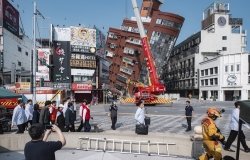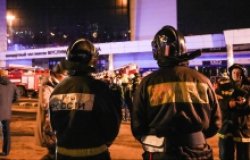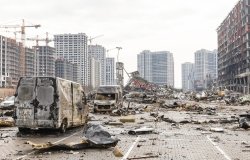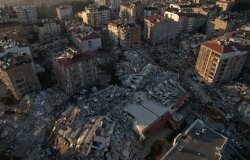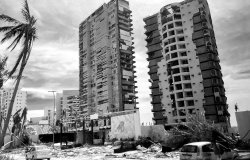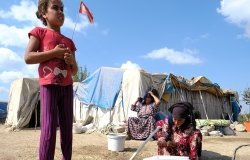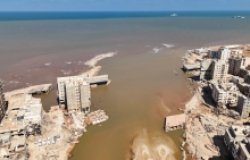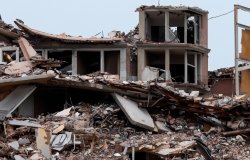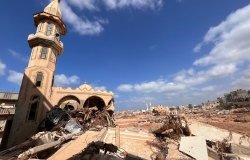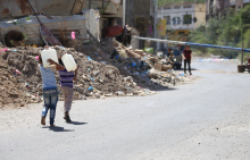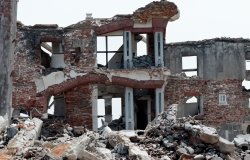After the Storm: Environment and Population Issues in Gulf Coast Reconstruction and Global Implications for Coastal Development
Robert A. Thomas, who holds the Chair of Environmental Communications at the University of Loyola in New Orleans, speaks about the environmental and demographic aspects of post-hurricane reconstruction in the Gulf Coast.
Overview
Robert A. Thomas, who holds the Chair of Environmental Communications at the University of Loyola in New Orleans, spoke at a recent Environmental Change and Security Program event about the environmental and demographic aspects of post-hurricane reconstruction in the Gulf Coast. Thomas opened his presentation with an image of a pictograph that has become a unique symbol of the impact of Hurricane Katrina on the city of New Orleans. Found on his own home, the cryptic "X" over "0," surmounted by "9-12," indicates that on September 12, rescue workers did not find any bodies when they searched his house. Like the blood marking the doors of those "passed over" by the biblical Angel of Death, these signs scrawled on flooded houses all over New Orleans are bittersweet emblems for the hurricane's survivors.
The Big One: "We all knew this was going to happen"
Pointing to a 20-year-old Army Corps of Engineers study that mapped the likely paths of potential hurricanes, Thomas said that Hurricane Katrina followed the path the Corps deemed "critical to New Orleans." While human intervention cannot prevent natural disasters, Thomas did note that coastal wetlands—which are slowly and steadily being depleted in the Gulf Coast—have historically slowed hurricanes before they made landfall. "For every 2.7 miles of healthy marsh, the tidal surge is diminished by one foot," he said. "When I was in college, you had 70 miles of healthy, coastal wetlands…Today you have 50 miles of depleted wetlands, with lots of pockets and holes. Do the math." Referring to the hurricane season of 1995, Thomas explained that Hurricane Danny was the first on record to cross the barrier islands—once uninhabited coastal islands undergoing rapid development—and grow stronger. According to Thomas, it was common knowledge that New Orleans would eventually be in the path of a hurricane that would cause mass destruction: "We all knew this was going to happen…America's emergency preparedness is ill-equipped for large disasters," he said.
Sorting Through the Rubble
 Thomas, who has lived and worked in New Orleans for much of his life, touched on some of the many environmental, social, and economic fears surrounding the reconstruction of the Gulf Coast. Posing a series of rhetorical questions, Thomas examined the complicated and convoluted nature of rebuilding. Environmentally, Thomas said, the pollution of Lake Pontchartrain, leaking sewage pipes, oil spills, and lack of potable water pose serious, long-term problems for New Orleans. But before tackling these issues, the city and region must first figure out what to do with the debris left by the storm. A cleanup worker told Thomas that the wreckage from Katrina is so vast it would cover 28 football fields and reach the height of the Empire State Building. "Where is all this garbage supposed to go?" he asked.
Thomas, who has lived and worked in New Orleans for much of his life, touched on some of the many environmental, social, and economic fears surrounding the reconstruction of the Gulf Coast. Posing a series of rhetorical questions, Thomas examined the complicated and convoluted nature of rebuilding. Environmentally, Thomas said, the pollution of Lake Pontchartrain, leaking sewage pipes, oil spills, and lack of potable water pose serious, long-term problems for New Orleans. But before tackling these issues, the city and region must first figure out what to do with the debris left by the storm. A cleanup worker told Thomas that the wreckage from Katrina is so vast it would cover 28 football fields and reach the height of the Empire State Building. "Where is all this garbage supposed to go?" he asked.
Addressing social and cultural concerns, Thomas asked whether the loss of jobs, small businesses, tourism, and residents would cost the city its "Gumbo Culture"—the music, food, and people that, collectively, made New Orleans such a unique destination. Finally, the national and international implications of the disruption wrought by Katrina were made plain to Thomas when he flew out of New Orleans and saw the barges stacked up along the Mississippi, all waiting to leave the port of New Orleans to deliver goods all over the world.
Equitable Development: Social Responsibility in Rebuilding the Gulf
Population demographics are fundamental to understanding the repercussions of modern natural disasters, according to Thomas. As the world's population grows and development increases in areas susceptible to natural disasters—hurricane paths, tornado alleys, fault lines—so too increases the extent of damage wrought by these disasters, exacted in the form of lost lives, homes, businesses, and jobs. To rebuild, Thomas said, the government must choose from myriad reconstruction options, many of which are the subject of fierce debate.
Two of the most controversial options are: (1) not rebuilding at all; and (2) allowing reconstruction at each citizen or business owner's expense. The former option, Thomas believes, is not a viable way to manage current or future disasters. He asked, "What are we going to do if the San Andreas Fault collapses? Not rebuild San Francisco?" Should the government chose the latter option, Thomas urged officials to understand the cultural, economic, and historical significance of New Orleans: "Rebuild a ‘new' New Orleans that better serves the national interest while retaining the charm, character, and culture that Americans love about the city."
Drafted by Alicia Hope Herron.
Speaker
Hosted By

Environmental Change and Security Program
The Environmental Change and Security Program (ECSP) explores the connections between environmental change, health, and population dynamics and their links to conflict, human insecurity, and foreign policy. Read more

Maternal Health Initiative
Life and health are the most basic human rights, yet disparities between and within countries continue to grow. No single solution or institution can address the variety of health concerns the world faces. By leveraging, building on, and coordinating the Wilson Center’s strong regional and cross-cutting programming, the Maternal Health Initiative (MHI) promotes dialogue and understanding among practitioners, scholars, community leaders, and policymakers. Read more
Thank you for your interest in this event. Please send any feedback or questions to our Events staff.
